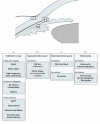Minimally Invasive Surgery, Implantable Sensors, and Personalized Therapies
- PMID: 33133445
- PMCID: PMC7591837
- DOI: 10.18502/jovr.v15i4.7792
Minimally Invasive Surgery, Implantable Sensors, and Personalized Therapies
Abstract
Glaucoma management has changed dramatically over the last decades, through clinical advances and technological revolutions. This review discusses the latest innovations and challenges faced in the field around three major axes: minimally-invasive glaucoma surgery (MIGS), implantable sensors and injectable therapeutics. Indeed, the vast number of recently developed MIGS techniques has not only provided clinicians with a wide range of therapeutic options, but they have also enabled them to adjust their therapies more finely which may have contributed a more patient-centric decision-making process. Yet, despite considerable advances in the field, the wide heterogeneity in clinical trial designs blurs the surgical outcomes, specificities and indications. Thus, more high-quality data are required to make the choice of a specific MIGS procedure more than an educated guess. Beyond the scope of MIGS, the potential of IOP telemetry for self-assessment of IOP-control through implantable sensors is developing into a real option for clinicians and an empowering opportunity for patients. Indeed, providing patients with direct feedback enables them to take control and have a clearer representation of their care, in turn leading to a better control of the disease. However, there are potential issues with self-monitoring of IOP, such as increased anxiety levels induced by measured IOP fluctuations and peaks, leading to patients self-treating during IOP spikes and additional office visits. Furthermore, the advent of implantable therapeutics may soon provide yet another step towards personalized glaucoma treatment, by offering not only an efficient alternative to current treatments, but also a therapeutic option that may better adapt to patients' lifestyle. After several decades of relative stagnation through the last century, glaucoma has now entered what many view as a golden age for the specialty. Like every revolution, this one brings its fair share of uncertainty, clinical questioning and uneasy periods of adaptation to ever-changing expectations. Yet, while it is impossible to guess what the landscape of glaucoma surgery will be like in ten or fifteen years, data suggest a bright outlook both for patients and clinicians.
Keywords: Bimatoprost SR; Eyemate; MIGS; Quality of Life; Telemetry; Glaucoma.
Copyright © 2020 Gillmann et al.
Conflict of interest statement
There are no conflicts of interest.
Figures




References
-
- Tham YC, Li X, Wong TY, Quigley HA, Aung T, Cheng C-Yu. Global prevalence of glaucoma and projections of glaucoma burden through 2040. A systematic review and meta-analysis. Ophthalmology 2014;121:2081–2090. - PubMed
-
- Chen CW. Enhancing intraocular pressure controlling effectiveness of trabeculotomy by local application of mitomycin C. Trans Asia Pac Acad Ophthalmol 1983;9:172–177.
-
- Saheb H, Ahmed, II. Micro-invasive glaucoma surgery: current perspectives and future directions. Curr Opin Ophthalmol 2012;23:96–104. - PubMed
-
- Gottanka J, Chan D, Eichhorn M, Lutjen-Drecoll E, Ethier CR. Effects of TGF-beta2 in perfused human eyes. Invest Ophthalmol Vis Sci 2004;45:153–158. - PubMed
Publication types
LinkOut - more resources
Full Text Sources
Research Materials
